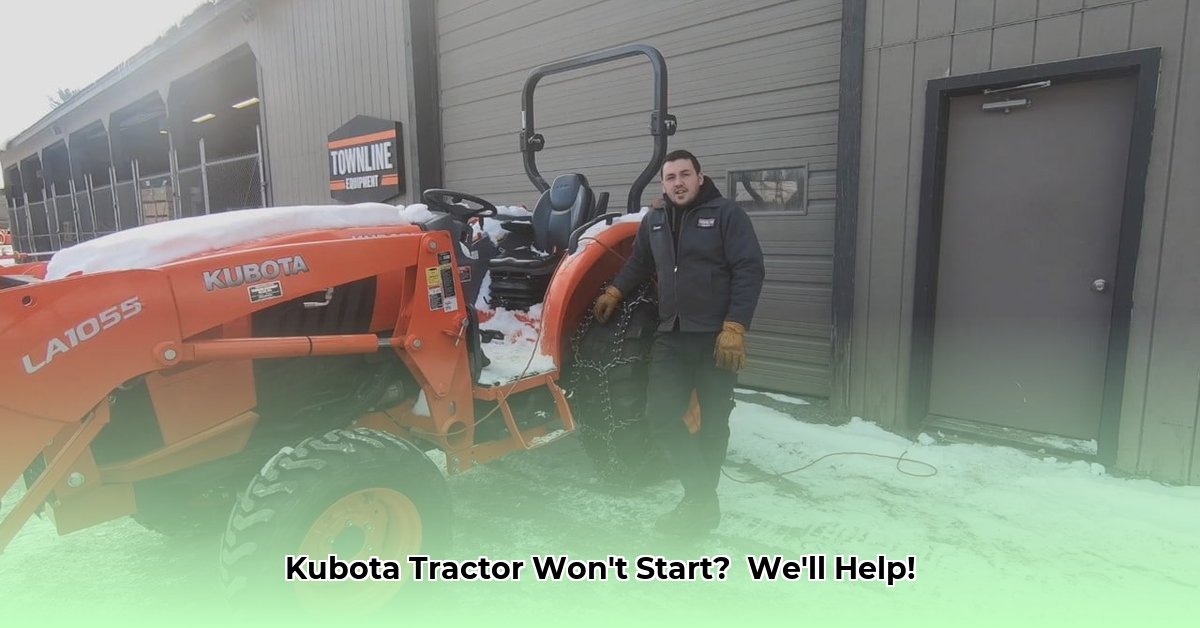
How Do You Start a Kubota Tractor?
Starting your Kubota tractor should be straightforward. This guide provides a step-by-step process for both novice and experienced users, covering pre-start checks, the starting procedure, troubleshooting common issues, and essential safety precautions. We’ll also address how to handle various Kubota models and their specific needs. For more detailed model-specific instructions, check out the Kubota Tractor Manual.
Before You Start: Essential Pre-Start Checks
Before turning the key, a quick pre-flight check is vital to prevent problems and ensure a safe start. This simple routine can save you time and potential costly repairs. Remember, always consult your owner's manual for model-specific details and recommendations.
Fuel Level: Check your fuel gauge. Insufficient fuel is a common cause of starting difficulties. (Ensure your fuel tank has enough fuel to complete your intended work.)
Engine Oil: Verify the oil level using the dipstick. Low oil levels can cause serious engine damage. Add oil if necessary, using the type and amount specified in your owner's manual. (Low oil can lead to catastrophic engine failure.)
Battery Condition: Inspect the battery terminals for corrosion and secure connections. A weak or dead battery is a frequent starting culprit. (Clean terminals and ensure a tight connection.) Consider using a multimeter to check the battery voltage if you suspect low charge.
Coolant Level: Check your coolant reservoir, especially in warm weather. Low coolant levels can lead to overheating. (Ensure the coolant is within the manufacturer's recommended range.)
Fluid Leaks: Conduct a quick visual inspection for any visible leaks around the engine, transmission, and hydraulic systems. Addressing leaks early prevents larger problems. (Early detection of leaks can prevent costly repairs.)
Starting Your Kubota: A Step-by-Step Guide
Following the pre-start checks, the actual starting process is usually quite simple. However, remember that specific procedures may vary slightly depending on your Kubota model. Always refer to your owner's manual for detailed model-specific instructions.
Engage the Parking Brake: For safety, always engage the parking brake before starting. This prevents accidental movement and ensures a secure start. (Never attempt to start your tractor without engaging the parking brake.)
Turn the Ignition to "ON": Insert the key and turn it to the "ON" position. This primes the engine's electrical systems. (You might hear some clicks and whirring sounds as the systems initialize.)
Start the Engine: Turn the key to the "START" position. The engine should crank and start. Don't crank excessively long if it doesn't start immediately; this can drain the battery. (If the engine fails to start after a few attempts, move to the troubleshooting section.)
Engine Warm-up: Allow the engine to run for a few minutes before engaging the PTO or applying a load. This ensures proper lubrication and prevents wear and tear. (Warming up the engine is crucial, especially in colder temperatures.)
Troubleshooting: Common Starting Problems and Solutions
Even with meticulous pre-start checks, starting issues may arise. Here’s a breakdown of common problems and solutions:
| Problem | Possible Causes | Troubleshooting Steps |
|---|---|---|
| Dead Battery | Corroded terminals, low charge, aging battery | Clean terminals, jump-start with a charged battery, consider battery replacement |
| Fuel Problems | Clogged fuel filter, empty tank, water in the fuel | Check fuel level, inspect and replace the fuel filter (if needed), drain any water from the fuel tank |
| Engine Won't Crank | Faulty solenoid, bad starter motor, loose electrical connections | Check all electrical connections, inspect the solenoid and starter motor. Professional assistance may be needed. |
| Engine Cranks but Doesn't Start | Low compression, faulty fuel pump, ignition problems | Seek professional help; diagnosing these issues requires specialized tools and expertise. |
Important: If you're unable to resolve the issue, consult your owner's manual or contact a qualified Kubota mechanic. Improper repairs can worsen the problem.
Safety First: Prioritizing Safety During Operation
Safety is paramount when working with machinery. Always prioritize safe practices:
Clear the Area: Before starting, ensure the area around the tractor is free of obstructions and people. (Maintain a safe distance from moving parts.)
Personal Protective Equipment (PPE): Wear appropriate safety gear, including work gloves, safety glasses, and sturdy, closed-toe shoes. (Protecting yourself from potential hazards is crucial.)
Post-Start Checks: Ensuring Smooth Operation
After starting your Kubota, make these brief checks:
Oil Pressure: Verify that the oil pressure gauge shows a normal reading. Low oil pressure requires immediate attention. (Low pressure indicates a potential problem.)
Engine Temperature: Monitor the engine temperature gauge to ensure it rises to the normal operating temperature. (Overheating can cause serious engine damage.)
Conclusion: Maintaining Your Kubota for Long-Term Performance
Your Kubota tractor’s owner's manual is your ultimate guide for detailed instructions, safety information, and model-specific troubleshooting. Regular maintenance – including oil changes, filter replacements, and general inspections – is crucial for long-term performance and reliability. By following these simple steps and prioritizing safety, you can get the most out of your Kubota for years to come.